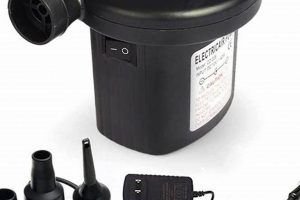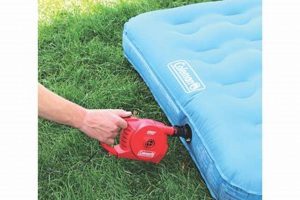A specialized support surface designed to redistribute pressure, primarily for individuals at risk of or already exhibiting pressure injuries. These surfaces typically consist of interconnected air cells that inflate and deflate in an alternating pattern, cyclically relieving pressure from vulnerable areas of the body. This cyclical inflation and deflation is achieved through an attached pump that manages the airflow. As an example, a patient confined to bed for extended periods may utilize this technology to prevent the development of pressure ulcers.
The use of pressure redistribution surfaces is important in healthcare settings for several reasons. They aid in the prevention and treatment of pressure injuries, which can lead to pain, infection, and prolonged hospital stays. Such support surfaces also improve patient comfort by minimizing areas of constant pressure. Historically, efforts to alleviate pressure have included frequent turning and repositioning of patients. However, this technology offers a more consistent and automated method of achieving pressure relief. The development of these mattresses represents a significant advancement in preventative and therapeutic patient care.
The following sections will delve into the mechanisms of operation, clinical efficacy, selection criteria, maintenance protocols, and potential limitations associated with these specialized support systems. Furthermore, future trends and technological advancements in this field will also be discussed. These discussions aim to provide a comprehensive understanding of these devices and their role in modern healthcare.
Usage Guidance
The following guidelines are intended to optimize the effectiveness and lifespan of pressure redistribution surfaces.
Tip 1: Select the Appropriate Surface. Consider factors such as patient weight, risk factors for pressure injury development, and the presence of existing wounds when choosing a specific model. Heavier patients may require higher-capacity systems, while those with existing ulcers need enhanced pressure relief.
Tip 2: Ensure Proper Inflation. Confirm that the system is fully inflated before patient placement. Under-inflation reduces the therapeutic benefit and may contribute to pressure concentration. Regularly monitor the inflation levels according to manufacturer specifications.
Tip 3: Use Appropriate Linens. Avoid thick or heavily layered bedding, which can reduce the effectiveness of pressure redistribution. Opt for breathable, moisture-wicking fabrics to minimize skin maceration.
Tip 4: Implement Scheduled Repositioning. While the surface provides pressure relief, it should not replace regular patient repositioning. Adhere to established repositioning protocols to further minimize prolonged pressure on bony prominences.
Tip 5: Conduct Routine Inspections. Regularly inspect the surface for damage, such as punctures or leaks, which can compromise its function. Address any issues promptly to maintain optimal performance.
Tip 6: Follow Cleaning and Disinfection Protocols. Adhere to manufacturer guidelines for cleaning and disinfecting the surface between patients to prevent cross-contamination. Use approved cleaning agents that will not degrade the material.
Tip 7: Monitor Skin Condition. Regularly assess the patient’s skin for signs of pressure injury development, regardless of the support surface in use. Early detection and intervention are crucial for preventing serious complications.
Proper utilization and maintenance are paramount to maximizing the benefits of these surfaces, contributing to improved patient outcomes and reduced healthcare costs.
The subsequent sections will address troubleshooting techniques and considerations for alternative pressure redistribution strategies.
1. Pressure Redistribution
Pressure redistribution forms the core therapeutic principle underlying the functionality of alternating air pressure mattresses. The alternating inflation and deflation of air cells systematically shifts areas of pressure, preventing prolonged compression of tissues and capillaries. This is critical because sustained pressure exceeding capillary closing pressure (approximately 32 mm Hg) impedes blood flow, leading to ischemia, tissue damage, and, ultimately, pressure ulcer formation. Without effective pressure redistribution, vulnerable areas such as the sacrum, heels, and ischial tuberosities are at high risk, especially in immobile patients.
As a real-life example, a patient recovering from a stroke and experiencing hemiparesis is at increased risk of pressure injury due to reduced mobility and sensation. An alternating air pressure mattress would provide cyclical pressure relief to the affected side, mitigating the risk of tissue breakdown. The effectiveness of this system depends on several factors: the cycle time (duration of inflation/deflation), the pressure settings within the air cells, and the patient’s individual risk factors. The importance of this understanding lies in guiding the selection of the appropriate mattress and optimizing its settings to meet the unique needs of each patient.
In summary, pressure redistribution, facilitated by alternating air pressure, is the fundamental mechanism by which these mattresses prevent pressure injuries. Recognizing the cause-and-effect relationship between pressure, blood flow, and tissue integrity underscores the importance of proper selection and use of these systems. Ongoing assessment and adjustments are crucial to ensure effective pressure relief and prevent the devastating consequences of pressure ulcers.
2. Cycle Duration
Cycle duration, referring to the time interval for a complete inflation and deflation sequence within an alternating air pressure mattress, directly impacts its therapeutic efficacy. The inflation phase applies pressure to the support surface, providing support. The subsequent deflation phase relieves pressure from specific areas, promoting reperfusion of previously compressed tissues. The length of each cycle dictates the duration of pressure relief and the time allowed for blood flow restoration. An inappropriately short cycle may not provide sufficient time for adequate reperfusion, while an excessively long cycle can prolong periods of pressure, negating the intended benefit. A critical component of this support system is the adjustment based on individual patients needs.
Consider a patient with compromised peripheral circulation secondary to diabetes. In such cases, a longer cycle duration, allowing for extended periods of pressure relief, may be more beneficial in promoting tissue oxygenation. Conversely, an individual at high risk for skin breakdown due to significant edema might require a shorter cycle duration to frequently redistribute pressure and prevent fluid accumulation in dependent areas. A case st
udy involving post-operative patients revealed a notable reduction in pressure injury incidence among those using mattresses with adjustable cycle durations, as opposed to those on mattresses with fixed settings. This highlights the practical significance of cycle duration as a tunable parameter for optimizing patient outcomes. Understanding the importance of cycle duration permits proper selection and optimized usage.
In conclusion, cycle duration is a critical component influencing the effectiveness of an alternating air pressure mattress. Its careful consideration, tailored to individual patient characteristics and risk factors, is essential for preventing pressure injuries and maximizing therapeutic benefits. Further research is ongoing to refine cycle duration recommendations based on specific patient populations and clinical conditions, emphasizing its continued importance in pressure ulcer prevention strategies.
3. Pump Operation
The pump constitutes the engine of an alternating air pressure mattress system, critically governing the cyclical inflation and deflation of the air cells responsible for pressure redistribution. Its function is to deliver a consistent and precisely regulated airflow to the mattress, dictating the pressure within each cell and the timing of the alternating cycle. A malfunctioning pump negates the therapeutic benefit of the mattress, rendering it akin to a static surface and increasing the risk of pressure injury development. The importance of pump operation lies in its direct influence on pressure relief and tissue perfusion. For instance, a pump with inadequate pressure output will fail to adequately inflate the cells, preventing effective weight distribution and potentially leading to localized areas of high pressure. Conversely, erratic pump operation, characterized by inconsistent pressure or cycle times, compromises the cyclical pressure relief essential for preventing tissue breakdown.
In practical application, healthcare facilities rely on regular pump maintenance and calibration to ensure optimal performance. Protocols often include routine inspections for leaks, obstructions, and motor functionality. Furthermore, some advanced systems incorporate pressure sensors and feedback mechanisms that dynamically adjust pump output based on patient weight and body position. This active pressure regulation enhances the mattress’s ability to effectively redistribute pressure, regardless of patient movement. A real-world example is the implementation of a preventative maintenance program in a long-term care facility, where regular pump checks and repairs significantly reduced the incidence of pressure ulcers among bedridden residents. These preventative measures ensure the longevity of the device and increase positive patient outcomes.
In summary, reliable pump operation is indispensable for the effectiveness of alternating air pressure mattresses. Consistent pressure output, precise cycle timing, and adherence to maintenance protocols are all crucial elements. Potential challenges include pump malfunction, power outages, and inadequate staff training on proper pump settings. Continued technological advancements are focused on enhancing pump reliability, integrating smart monitoring capabilities, and simplifying user interfaces to ensure consistent and effective pressure relief in diverse healthcare settings. Further research and development aim to optimize pump technology, promoting long-term reliability and efficacy of pressure redistribution systems.
4. Material Composition
Material composition plays a significant role in the functionality, durability, and safety profile of alternating air pressure mattresses. The materials employed directly impact the mattress’s ability to redistribute pressure, resist bacterial colonization, and withstand the rigors of a healthcare environment. Selection of appropriate materials is, therefore, paramount for ensuring both patient comfort and optimal therapeutic outcomes.
- Surface Fabric Permeability
The outer layer of the mattress, typically fabric, must balance breathability with fluid resistance. A highly permeable fabric facilitates air circulation, minimizing moisture buildup and reducing the risk of skin maceration. However, it must also resist penetration by bodily fluids to prevent contamination of the underlying air cells. For example, polyurethane-coated nylon fabrics offer a suitable compromise, providing both breathability and fluid impermeability. The choice directly influences the microclimate at the patient-surface interface, a critical factor in pressure injury prevention.
- Air Cell Polymer Integrity
The air cells themselves, responsible for pressure redistribution, are typically constructed from polymers such as PVC or TPU (thermoplastic polyurethane). PVC offers cost-effectiveness but can be less durable and more prone to cracking over time, especially with repeated inflation and deflation cycles. TPU, while more expensive, exhibits superior flexibility, tear resistance, and biocompatibility. A mattress employing TPU air cells is better suited for long-term use and can withstand higher levels of patient weight and movement. This relates directly to the functional lifespan of the system.
- Antimicrobial Additives
Given the potential for bacterial colonization in healthcare settings, the incorporation of antimicrobial additives into the mattress materials is a crucial consideration. These additives, such as silver ions or triclosan, inhibit the growth of bacteria and fungi, reducing the risk of infection transmission. Mattresses incorporating antimicrobial materials are particularly valuable in intensive care units or other environments where patients are at high risk of infection. The long-term efficacy and potential for microbial resistance development, however, necessitate careful selection and monitoring of these additives.
- Flame Retardancy Standards
Adherence to flame retardancy standards is a mandatory safety requirement for all medical devices, including alternating air pressure mattresses. Materials used in construction must meet stringent flammability tests to minimize the risk of fire hazards in healthcare facilities. Chemical flame retardants are often incorporated into the fabric and polymer components. However, concerns regarding the potential toxicity of some flame retardants have led to the development of alternative, halogen-free formulations. The choice of flame retardant must balance fire safety with potential health risks.
In conclusion, the material composition of alternating air pressure mattresses is a multifaceted consideration, impacting not only functionality and durability but also patient safety and infection control. The careful selection of materials, balancing performance characteristics with regulatory requirements, is essential for optimizing the therapeutic efficacy and long-term value of these devices. Future innovations may focus on developing novel biomaterials with enhanced pressure redistribution capabilities, inherent antimicrobial properties, and improved biocompatibility.
5. Weight Capacity
Weight capacity is a critical specification for alternating air p
ressure mattresses, directly influencing their therapeutic effectiveness and patient safety. The maximum weight a mattress can support while maintaining its pressure redistribution properties is a primary determinant of its suitability for individual patients. Exceeding the stated weight limit can compromise the mattress’s performance, potentially leading to localized areas of high pressure and an increased risk of pressure injury development.
- Air Cell Volume and Pressure Range
The air cell volume and the pump’s ability to generate and maintain pressure are directly related to weight capacity. Mattresses designed for heavier individuals typically feature larger air cells and more powerful pumps to ensure adequate support and pressure relief. For example, a bariatric mattress might utilize air cells with significantly greater volume compared to a standard model, enabling it to distribute weight more effectively. The mattress is rated to safely operate and alleviate pressure, as designed.
- Material Stress and Durability
Exceeding the weight capacity places undue stress on the mattress materials, potentially leading to premature wear and tear, seam failures, and air leaks. These issues compromise the mattress’s ability to maintain consistent pressure distribution and can result in costly repairs or replacements. High-quality materials and robust construction are essential for mattresses intended to support heavier patients.
- Pressure Mapping and Interface Pressure
Weight capacity is often determined through pressure mapping studies, which measure the pressure exerted on the patient’s body at various points of contact. These studies identify areas of high pressure concentration, allowing manufacturers to optimize the mattress design and weight rating. Exceeding the weight capacity can invalidate these pressure mapping results, leading to unpredictable pressure distribution and an increased risk of pressure injuries.
- Patient Safety and Support Surface Stability
Weight capacity considerations extend beyond pressure injury prevention to encompass overall patient safety. An overloaded mattress may become unstable, increasing the risk of falls or other accidents. Manufacturers design mattresses to maintain a stable surface within the stated weight limit, ensuring a safe environment for the patient. This is especially critical for patients with mobility limitations or cognitive impairments.
In conclusion, weight capacity is an essential parameter to consider when selecting an alternating air pressure mattress. It directly influences the mattress’s ability to effectively redistribute pressure, maintain structural integrity, and ensure patient safety. Matching the mattress’s weight capacity to the patient’s weight is paramount for optimizing therapeutic outcomes and minimizing potential complications. Ongoing research and development focus on creating mattresses with wider weight ranges and enhanced pressure redistribution capabilities to accommodate the diverse needs of patient populations.
Frequently Asked Questions
The following questions address common concerns and misconceptions regarding the proper use and functionality of alternating air pressure mattresses in healthcare settings.
Question 1: What are the primary indications for utilizing an alternating air pressure mattress?
These mattresses are primarily indicated for individuals at high risk of developing pressure injuries due to immobility, decreased sensory perception, or compromised nutritional status. They are also utilized in the treatment of existing Stage I and II pressure ulcers to facilitate healing.
Question 2: How does an alternating air pressure mattress differ from a standard hospital mattress in terms of pressure redistribution?
Unlike standard mattresses, which provide static support, these systems utilize a cyclical inflation and deflation of air cells to redistribute pressure across the patient’s body. This dynamic pressure relief prevents prolonged compression of tissues, promoting blood flow and minimizing the risk of tissue damage.
Question 3: What are the key factors to consider when selecting an alternating air pressure mattress for a specific patient?
Important considerations include patient weight, risk factors for pressure injury development, presence of existing wounds, and level of mobility. The mattress’s weight capacity, cycle duration, cell design, and material composition should be carefully evaluated to ensure suitability for the individual patient’s needs.
Question 4: How frequently should an alternating air pressure mattress be inspected and maintained to ensure optimal performance?
These mattresses should be inspected daily for signs of damage, such as leaks, tears, or pump malfunctions. Regular cleaning and disinfection, according to manufacturer guidelines, are also essential to prevent bacterial contamination. Preventative maintenance, including pump calibration and air cell replacement, should be performed as recommended by the manufacturer.
Question 5: What are the potential contraindications for using an alternating air pressure mattress?
While generally safe, these mattresses may not be appropriate for patients with unstable spinal fractures, certain types of traction, or severe hemodynamic instability. Consultation with a physician or wound care specialist is recommended to determine the suitability of the mattress for individual patients.
Question 6: Does the use of an alternating air pressure mattress eliminate the need for regular patient repositioning?
No. While these mattresses provide pressure redistribution, they do not replace the need for regular patient repositioning. Adherence to established repositioning protocols, typically every two hours, remains crucial for preventing pressure injuries, even when utilizing an alternating air pressure mattress.
In summary, alternating air pressure mattresses are valuable tools for pressure injury prevention and treatment, but their effectiveness depends on proper selection, utilization, and maintenance. Clinicians should carefully consider patient-specific factors and adhere to established guidelines to optimize outcomes.
The next section will explore the future trends and technological advancements in the realm of pressure redistribution surfaces.
Conclusion
The preceding sections have comprehensively explored the operational mechanisms, benefits, and considerations surrounding alternating air pressure mattresses. From their fundamental function in pressure redistribution to the nuances of cycle duration, pump operation, material composition, and weight capacity, a thorough understanding is critical for effective implementation. Emphasis has been placed on the importance of selecting the appropriate mattress for individual patient needs and adhering to rigorous maintenance protocols.
The continued advancement of alternating air pressure mattress technology holds the promise of further reducing the incidence of pressure injuries and improving patient outcomes. Vigilance in monitoring patient skin integrity, coupled with adherence to best practices, remains paramount. Healthcare professionals must remain informed of evolving technologies and integrate evidence-based strategies to optimize the utilization of these support surfaces, ultimately contributing to enhanced patient care and reduced healthcare costs. Prioritizing patient well-being necessitates a continued commitment to advancing and refining pressure ulcer prevention strategies.







